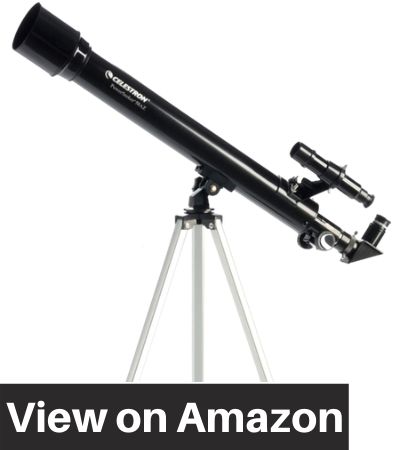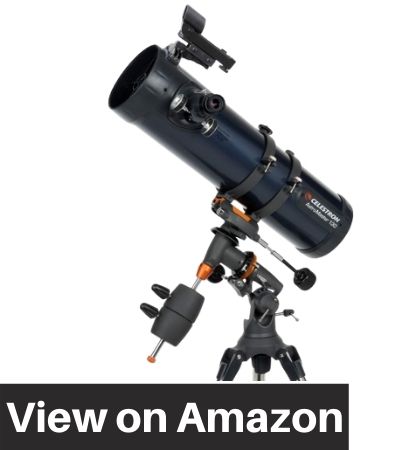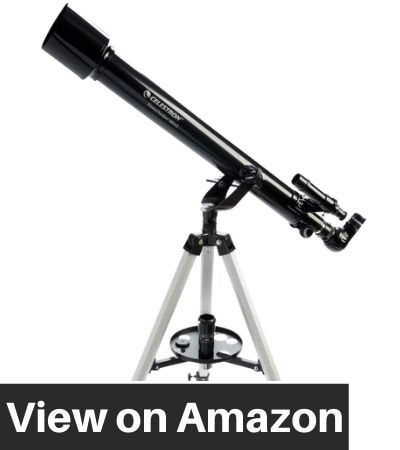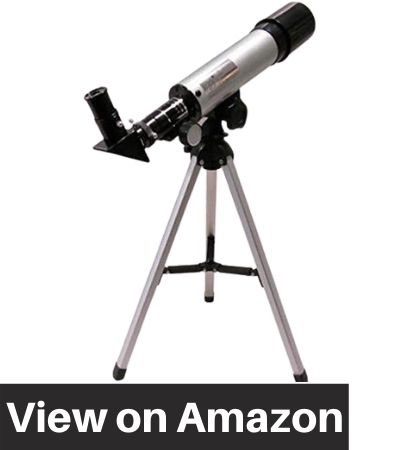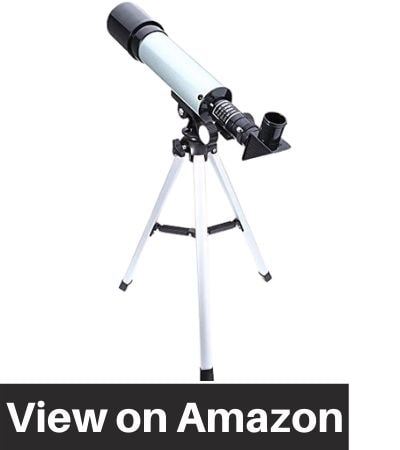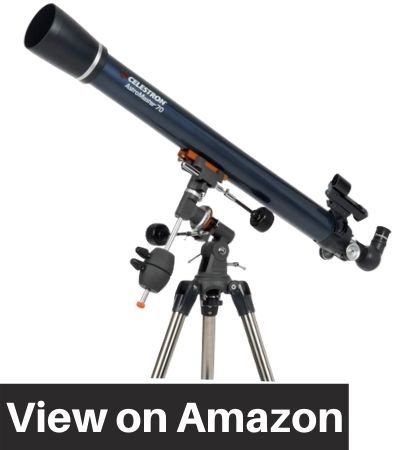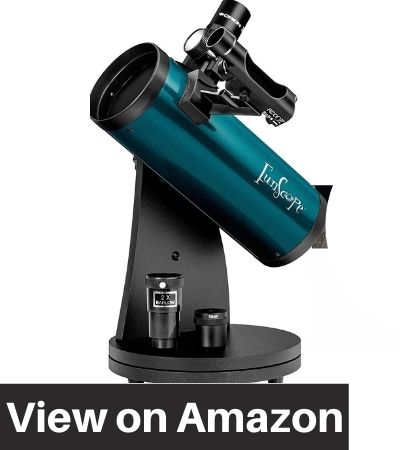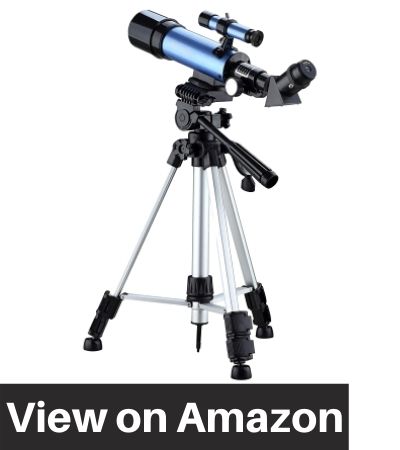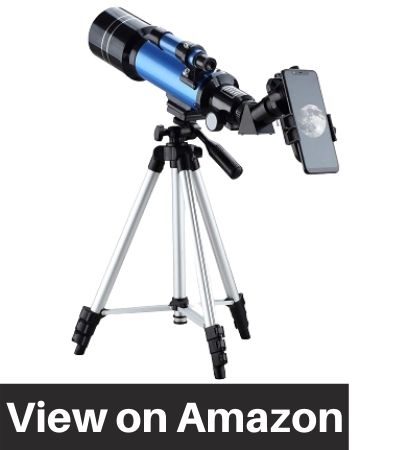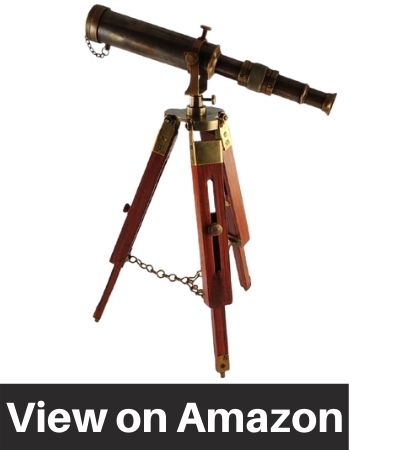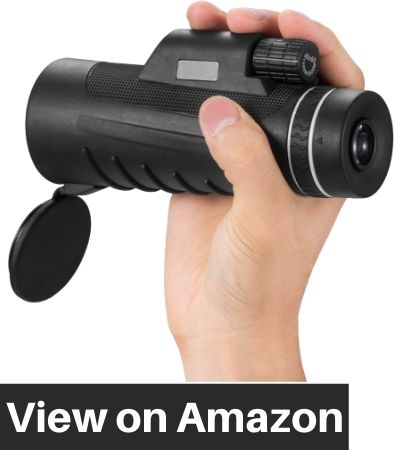There are many wonders around the world which keep us intrigued for hours but the study of space, astronomical bodies like the planets, moons, stars, etc. has always been a subject of immense interest.
It is a never-ending topic as the universe keeps expanding over-ages. Before diving deep into the stars & planets, you need to have a basic instrument called Telescope.
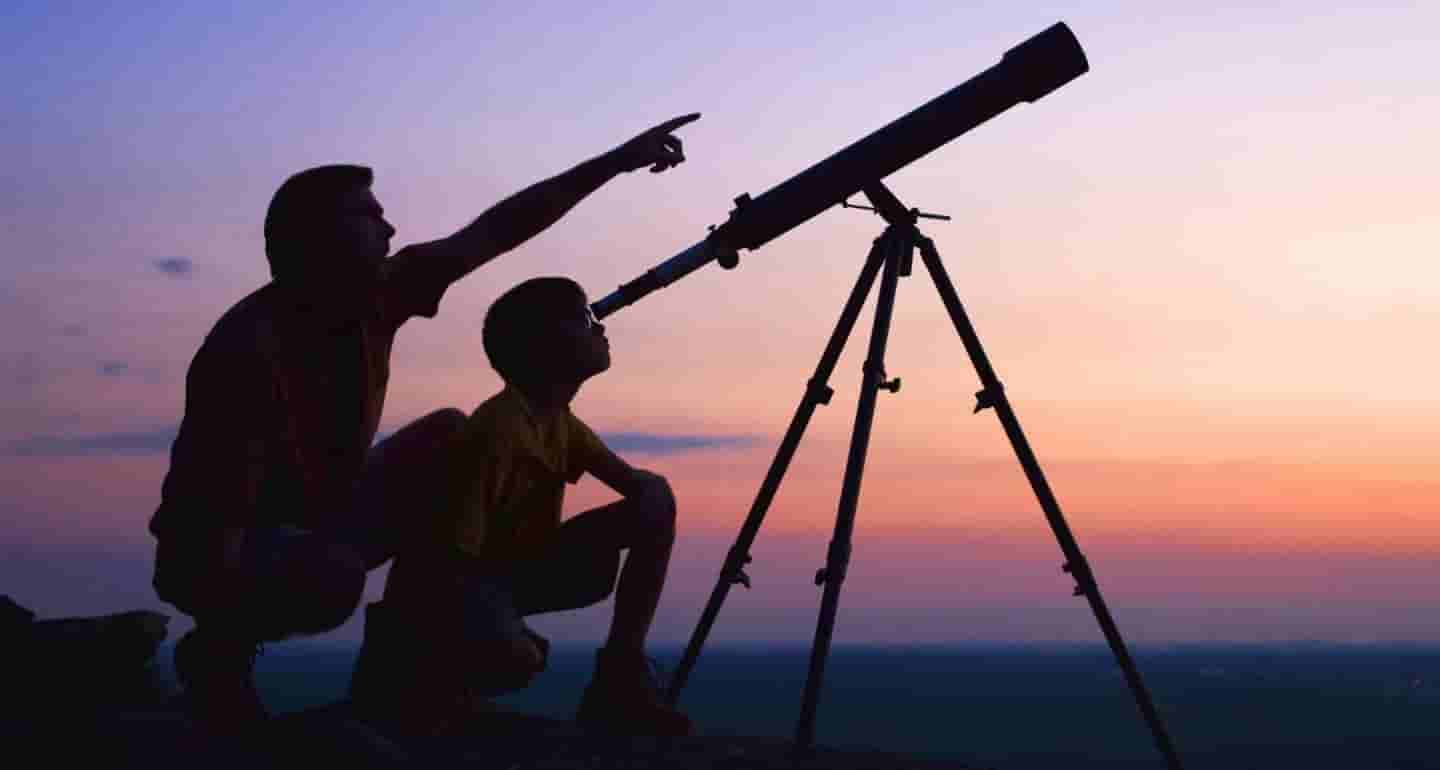
A telescope is an optical device that is used for star-gazing or view the celestial objects more clearly that cannot be interpreted with naked eye.
The basic fundamental behind the usage of this instrument is the usage of electromagnetic radiation emitted, absorbed, or reflected by the celestial bodies.
So, if you are looking to buy a telescope, you are at the right place! Here you will only get information about the Top 11 Best Telescopes in India but also get knowledge about the things to consider while buying the best telescope.
We highly recommend you to read the Buying Guide on this page that would help you to make an apt choice.
These are the Top 11 Best Telescopes in India
| Products | Item Weight | Warranty | Buy Now |
|---|---|---|---|
| Celestron Power Seeker 21039 Telescope | 1.63 Kg | 2 years | |
| Celestron AstroMaster 114EQ Telescope | 12 Kg | 2 years | |
| Celestron PowerSeeker 60AZ Telescope | 3.40 Kg | 2 years | |
| SHREVI IMPEX Land and Sky 90x Zoom Refractor Telescope | 3 Kg | NA | |
| SKA™ 90X High Power Refractor Monocular Astronomical Telescope | 4 Kg | NA | |
| Celestron 21062 AstroMaster 70 EQ Refractor Telescope | 8.16 Kg | 1 year | |
| Orion 10033 FunScope 76mm TableTop Reflector Telescope | 1.81 Kg | 1 year | |
| Aomekie Kids Telescopes for Astronomy Beginners Refractor Telescope | 2.28 Kg | NA | |
| AOMEKIE Aomekie Telescopes | 1.88 Kg | 1 year | |
| Karmakara Antique Maritime Brass Telescope | 500 g | NA | |
| DEMACO Monocular Telescope | 5 Kg | NA |
Best Telescopes for Beginners in India (2023)
1. Celestron Power Seeker 21039 Telescope
The Celestron Power Seeker 21039 is one of the best telescopes in India that can be rotated in 2 directions that are perpendicular to each other (2-axes mount). One is vertical and the other is horizontal. This is a refracting telescope as it contains a lens as an objective element.
The lenses are provided with high transmission coatings on each side. Thus, preventing any reflection of light rays from the glass surfaces and hence the chromatic aberration. So, there won’t be any issue of blur and you can see clear and crisp images.
- Optical Design: Refractor (Glass optical lenses)
- Mount type: Altazimuth
- Ideal Usage: Terrestrial & Astronomical
- Aperture: 50mm
- Focal length: 600mm
- Focal number: 12
- Highest useful magnification: 118x
- Finderscope: 5×24
- Tripod: Adjustable with aluminium legs
- Lens coating: Fully coated
- Optical tube length: 610mm
- Eyepieces: 3 (20mm., 12mm., 4mm.)
The diameter of the objective lens is 50mm means it can be used to see stars in an astronomical sense and then terrestrial objects. So, this is pretty decent for beginners or people who are new to star gazing. The focal length is 600mm.
The focal length is 600mm. So, the focal number is 600mm/50mm = 12. This is the smallest number that can be set in this telescope. 3 eye pieces are provided with this telescope. They are 20mm, 12mm and 4mm.
So, this telescope provides magnification of 30x, 50x and 150x as 600mm/20mm = 30x, 600mm/12m = 50x and 600mm/4mm = 150x. But highest useful magnification is 118x.
This telescope is provided with Barlow Lens which is a 3x one. That means it can triple the magnification power and hence lets you see the Lunar Surface, moon, planets, star clusters, Orion Nebula and Andromeda Galaxy too.
So, 3 extra magnification powers are obtained along with existing ones with the Barlow lens. The finder-scope provided is 5×24 meaning it has 5x magnification and has an aperture of 24mm. So, it does not magnify much.
This telescope also comes with a tripod for making the observation smooth. It is adjustable meaning its height can be customized as per the requirement.
The legs are made of aluminium so making it strong and sturdy while being light-weight. It can be placed on a table too.
This tripod also has an accessory tray. A star diagonal is provided thus allowing you to ease the pain of looking vertically for a long time.
The angle of view for the lens is 1°. The product has dimensions of 83.83 x 12.7 x 20.32 cm., and a weight of 1.63 kgs.
There is no requirement for batteries or an AC adapter. There is no color screen. Minimum magnification id 5x and optical zoom is 3x. This product also provides Starry Night Educational software which will be very useful for beginners.
“The Sky” planetarium app contains snapshots and printable sky maps of more than 10,000 objects, 75 enhanced images that are very useful for a beginner. The material used for making the telescope is metal and comes in black color. It is small, portable and can be easily carried on trips.
2. Celestron AstroMaster 114 EQ Telescope
This telescope bears the style name of AstroMaster 130 EQ meaning it has an aperture of 130 mm & an Equatorial mount. This variant comes from the house of a popular brand called Celestron. This is a Reflecting Telescope meaning it has a mirror for image formation.
It is a Newtonian Reflector, which is considered one of the oldest types of telescope. In this telescope, a concave mirror is placed at the lower end and light enters from the upper end gets reflected by it.
- Optical Design: Newtonian Reflector
- Mount type: CG-3 Equatorial
- Ideal Usage: Terrestrial & Astronomical
- Aperture: 130mm
- Focal Length: 650mm
- Highest useful Magnification: 307x
- Finder-scope: Built-on Star Pointer
- Tripod: 1.25-inch steel tube legs
- Lens Coating: Aluminium
- Optical Tube Length: 610mm
A secondary mirror is placed which is used to deflect the reflected light ray by 90°. These deflected rays will fall on the eyepiece from where the image can be seen.
The aperture is 130 mm which means the diameter is big enough to observe stars, moon, stars like Jupiter, Saturn, and its rings. The images will be larger, brighter, and sharper as more-light can be gathered.
Since the objective element is mirror, there is no issue with light absorption or no proper bending which leads to a blurred image. With this large aperture, it is not only useful for beginners but also for serious astronomers.
Aluminium is used for silvering of the mirror (coating on the plane side) for complete reflection of light rays without any absorbance or transmittance.
2 eyepieces are provided with this telescope. They are 20mm and 10mm. Since the focal length is 650mm, the magnifications it gives is 650mm/20mm = 33x and 650mm/10mm = 65mm.
So, with this high magnification, you can watch fainter objects. Since the limiting magnification can go till double that of aperture, this telescope has a maximum useful magnification of 307x. The focal number is 650mm/130mm = 5.
The finder-scope provided is permanently Built-on Star Pointer that lets you pin-point the target easily using the Red-dot. The telescope is provided with Equatorial Mount (different from Altazimuth).
This is very much useful while continuously observing the moving targets. Since the earth is in continuous rotation (days & nights formation), it is difficult to focus on a single star as it moves and will be out of the field of view if the telescope is fixed.
It requires a change of position of telescope again and again which would be quite tedious. So, what this mount does is, it rotates about the earth axis just like the earth (1 RPD) but in a direction opposite to that of earth, then the telescope will be able to track the stars precisely!
This also allows attaching a camera, so that beautiful photos of celestial bodies can be captured. This German CG-3 Equatorial Mount has setting circles and slow-motion controls thus allowing you to find and track stars easily.
It is provided with a tripod made of stainless steel which is strong and sturdy letting the mount and telescope stand on it without any issue. The steel tube legs are 1.25 inch and the tripod has an accessory tray for putting extra equipment.
The tripod and mount are pre-assembled and it is manual. The product has dimensions of 88.9 x 48.26 x 30.48cm., and weight of 12.02 kgs, and comes in black color.
Along with these, a manual is provided for easy setup and usage of the telescope. The SkyX-First edition astronomy software is provided and the CD-ROM has about 10,000 objects database, printable sky maps, and 75 enhanced images.
3. Celestron PowerSeeker 60AZ Telescope
This Celestron 60AZ telescope is among the most popular telescopes in India. It comes with an aperture size of 60mm and has an Altazimuth mount. This telescope is a refracting one which means it has a glass optical lens for image formation.
The lens is fully coated to prevent any absorption of light rays and loss of clarity. The images obtained will be very clear. The objective lens has a diameter of 60mm. It means it is good enough to see stars, moon and star clusters, and also far terrestrial objects.
- Optical Design: Refractor (Glass optical lenses)
- Mount type: Altazimuth
- Ideal Usage: Terrestrial & Astronomical
- Aperture: 60mm
- Focal length: 700mm
- Highest useful magnification: 142x
- Finderscope: 5×24
- Tripod: Adjustable with aluminium legs
- Lens coating: Fully coated
- Optical tube length: 711mm
- Eyepieces: 2 (20mm; 4mm)
So, it is good enough for beginners. The focal length is 700mm. So, the focal ratio is 700mm/60mm = 12 which is good enough considering the speed of observing the objects. 2 eye-pieces are provided with this telescope, I.e., 20mm and 4mm.
So, the magnifications would be 700mm/20mm = 35x and 700mm/4mm = 175x which are very good for observing minute details on the surfaces of objects but dimmer. But maximum useful magnification is 142x beyond which the images will be blur and of no use.
The telescope is provided with a 3x Barlow lens. This is extremely useful in increasing magnification even with basic telescopes. The finder-scope provided lets to pin-point the object you want to observe.
It is of 5×24 meaning it has 5x magnification and has an aperture of 24mm. So, it does not magnify much. The mount or tripod given is Altazimuth.
It can be moved up and down, right or left with the help of pan-handle Alt-Az control with clutch. The telescope also comes with a tripod for making the observation smooth.
It is adjustable meaning its height can be customized as per the requirement. The legs are made of aluminium, so making it strong and sturdy while being light-weight.
It can be placed on a table too. This tripod also has an accessory tray. A star diagonal is provided thus allowing you to ease the pain of looking vertically for a long time.
It lets you get an erect image and hence the optical tube can be used in the day-time too. As star guide is provided along with the pack for setting up and usage of the telescope which is very useful for beginners.
The SkyX package software consists of an object database, printable sky maps that guide you while observing the celestial objects. The minimum magnification is 18x, optical zoom is 3x, minimum aperture is 51f and the real angle of view is 1°.
The aperture mode is under 80mm. It has no self-pace timer, rechargeable batteries as they are not required. It has no AC adapter and external memory. It has dimensions of 41.9 x 25.4 x 74.9 cm and has a weight of 3.4 kg, and is available in black.
4. SHREVI IMPEX Land and Sky 90x Zoom Refractor Telescope
This telescope is manufactured and provided by Shrevi Impex. This is a refracting telescope used for land and sky observation. This is a Monocular Refractor Telescope. This means it is like a combination of telescope and binoculars.
It uses a lens and sometimes, prism to zoom objects that are far away. But not as much as a telescope. So, it is excellent for viewing objects on land. High-end monocular telescopes usually use prisms.
- Optical Design: Refractor (glass lens)
- Aperture: 50mm
- Focal Length: 360mm
- Minimum magnification: 18x
- Barrel Body: Aluminium
- Magnification range: 18x- 90x
- Eyepieces: 20mm, 6mm, 1.5x erecting
- Porro Prism is present
- Sturdy Tripod
This telescope comes with Porro Prism. Prism is usually used along with lens in binoculars which is used for terrestrial observation. The usage of it is to make the image erect and the same as the object (not upside down!).
And also, they reflect the light rays thus lowering the optical path. In this, prisms are places in zig-zag way such that light rays reflect and turn 180o before going to eye-piece. These are heavier but give crisp images.
The focal ratio is 360mm/50mm = 7.2. The eyepieces are 20mm and 6mm. So, magnifications would be 360mm/20mm = 18x, 360mm/6mm = 60x.
Combining 6mm eyepiece with 1.5 erecting eye-piece, we get a magnification of 90x, and combining 20mm eyepiece with 1.5 erecting eyepiece, we get a magnification of 27x.
So, the range is 18x, 27x, 60x, 90x which is good for watching nature, birds clearly and night sky too, magnified. This erecting eyepiece makes the image upright and lets you observe objects on earth as they are (not upside down).
The tripod provided is made of aluminium alloy thus providing a sturdy base to the telescope to observe without any issue. The tripod is adjustable and the length of its legs are 36cm.
The height of the tripod is 38.1cm. The total length of the barrel body is 39cm. The interface button and focus adjustment wheel are provided.
This telescope lets you connect a digital card machine, camera as well as computer such that you can even click photos while observing. This telescope is good for birdwatching, city building, scenic nature, sun-spots, and the moon.
5. SKA™ 90X High Power Refractor Monocular Astronomical Telescope
This refractor telescope is manufactured and provided by SKA. This is useful for both sky and land observation. This is a monocular telescope, meaning a combination of telescope and binoculars. It has a series of lens for viewing objects. The aperture is 50mm.
So, it is good enough to watch the stars and moon. The focal length is 360mm. So, focal ratio is 360mm/50mm = 7.2. This f-number is low, so speed for watching will be more. The eyepieces provided are 20mm and 6mm.
- Optical design: Optical glass lens
- Aperture: 50mm
- Focal Length: 360mm
- Eyepieces: 20mm., 6mm., 1.5 erecting eyepiece
- Magnification range: 18x – 90x
- Barrel body: Metal
- Mount: Equatorial
- Tripod body: Aluminium
- Colors available: Silver & White
So, magnifications that could be obtained would be 360mm/20mm = 18x, 360mm/6mm = 60x. These are good enough to watch far-away objects on the earth and celestial objects like the moon.
The erect eyepiece of 1.5x is also provided. Also, it makes the images upright, so you can watch the objects on the earth as they are (not upside down).
The theoretical resolution by this telescope is 2.000 arc seconds. This is roughly equivalent to seeing 1000 m distant objects as 0.970 cm distant.
The resolution power lets you distinguish between 2 points in space which may not be understood by the human eye (for us they may appear as one as our eyes cannot gather much light to process).
A hybrid diagonal is provided which is a 90° angled one. So, it is very good for astronomical observations. The mount provided is a sturdy Equatorial one.
So, this lets you align the telescope with polar axis of the earth and let it be in parallel the latter thus allowing you to watch moving any particular star without getting lost or confused.
The tripod provided is sturdy to hold the mount and telescope well. The maximum height 38cm. It is made of aluminium. So, it is light-weight and strong.
The user manual is also provided for setting up the telescope which is very useful for beginners. The telescope is available in 2 colors, namely, silver and white but color choosing is not possible. So, you get whichever color is available.
6. Celestron 21062 AstroMaster 70 EQ Refractor Telescope
This telescope is manufactured and provided by Celestron. The 70EQ comes with an aperture is 70 mm, and Equatorial Mount is present. This is an Achromatic Refractor telescope as it is provided with an optical glass lens for image formation.
The objective lens has a diameter of 70mm., which is pretty good for astronomical observation. The optical glasses are all fully coated for clear images.
- Optical design: Refractor (glass optical lenses)
- Mount type: German Equatorial
- Ideal Usage: Terrestrial & Astronomical
- Aperture: 70mm
- 2-piece Objective Lens
- Focal length: 900mm
- Focal number: 13
- Tripod: Adjustable with aluminium legs
- Lens coating: Fully coated
- Eyepieces: 2 (10mm., 20mm.)
Along with this lens, a second lens is provided for any chromatic aberrations that may take place due to the lens. Usually, if the lens is not properly polished or if they have impurities or bubbles, then the light will not be refracted properly (absorption might take place).
Then, the light beam will not entirely focus to form the image but will lead to false color or blue fringes. So, to prevent this, the second lens is used. The focal ratio or focal number is 13 which is a bit high.
So, gives high magnification and lets you watch moon, planets, and stars with a narrower field of view. Also, optical distortions will be minimum. This is better than 50mm., or 60mm., beginner scopes.
2 eyepieces are provided I.e., 10mm. And 20mm., which give magnification of 900mm/10mm = 90x and 900mm/20mm = 45x. With these magnifications, you get brighter, sharper, and clear images.
A correct image diagonal prism is also provided such that erect images can be obtained (not upside down). Hence, viewing terrestrial objects is also easy. The finder-scope provided is a permanently mounted Star Pointer.
So, there is no hustle of setting it up and aligning every time you use the telescope. It lets you pin-point the deep sky objects easily with a red dot.
The mount provided is a German-style Equatorial mount. This addition is like cherry on top with this telescope because this telescope already has a good aperture and magnification for viewing deep space exploration.
With the addition to this mount, you can easily track moving stars of your choice. It has setting circles and slow-motion controls to track targets easily.
The tripod provided is made of steel thus making it very strong and sturdy. It makes a good platform to carry the weight of the telescope. The mount and the tripod are pre-assembled, so, there is no hustle in setting up this too.
The steel tube legs are 1.25 inch each and are adjustable at 46 inches and 58 inches height. An accessory tray is also provided with the tripod. The camera can also be attached to take photographs of the celestial bodies.
A user manual is given which is very useful for beginners and Sky-First Edition Planetarium software with 10,000 object database, enhanced images, printable sky maps is provided. The product dimensions are 24.5 x 103.5 x 38cm., and it weighs at 8.16kg., and available in black.
7. Orion 10033 FunScope 76mm TableTop Reflector Telescope
The Orion 10033 FunScope is a Dobsonian Reflector telescope made especially for kids to watch the moon and stars but also very useful for amateur astronomers. The aperture of 76 mm collects 60% more light than usual, beginner 60mm telescopes.
This Telescope is not only affordable but powerful too. It comes with have altazimuth mount that lets you move the scope up/down and right/left. They are reflecting telescopes. So, they use mirrors rather than lens.
- Optical Design: Reflector (spherical mirror)
- Aperture: 76mm (mode under 80mm.)
- Eyepiece: 20mm., 10mm
- 2x Barlow Lens
- Minimum Magnification: 11x
- Body material: Metal
- Batteries: 1 Lithium Metal battery (non-rechargeable)
- Mount: Dobsonian
- Finderscope: Red dot
The scope sits on the mount by friction. So, movement of it is less thus letting you observe the objects without shaking. The focal length is small. A wide field of view is obtained with the eyepieces.
This telescope is provided with 20mm., and 10mm., eyepieces thus allowing a wide field of view as well as brighter images. Since the tube is short, a fast opening is possible (f-number:4).
It lets you see craters on moon, planets, star clusters, and nebulas. Barlow lens is standard 2x type doubling the magnification you already get with the given eyepieces.
The finder-scope provided is Red dot letting you spot the targeted object easily. The entire mount and setup are made of heavy-grade aluminium thus making it sturdy and stable while doing the observation. 1 lithium battery is included.
The dimensions of the item are 20.3 x 20.3 x 34.3 cm, and weigh 1.81 kg hence letting you carry on field trips. It is a small, table-top telescope and is available in bright blue color. Moon kit is provided which consists of Orion Moon Map 260 that has names of craters and lunar features.
8. Aomekie Kids Refractor Telescope
This is a Refractor Telescope designed by Aomekie especially for kids and beginners in astronomy. This is an Achromatic Refractor Telescope means, it uses lens for image formation.
It uses fully coated optical glasses with high transmission coatings in order to minimize the problem of reflection by the lens. So, brighter, clear, and sharp images are obtained. Star gazing reflector is provided to reduce the problem of longitudinal chromatic aberration and correct the lateral chromatic aberration.
- Optical Type: Achromatic Refractor
- Objective Lens: 50mm
- Focal Length: 360mm
- Eyepieces: 8mm; 20mm
- Magnification: 18x-100x
- Mount: Altazimuth
- Finderscope: Mounting Bracket
- Prism: 45o Correct Image Prism Diagonal
- Tripod Material: Aluminium
It reduces distortion. The focal ratio is 360mm/50mm = 7.5 which means good speed for opening. The magnifications obtained with the eyepieces provided are 360mm/8mm = 45x and 360mm/20mm = 18x, good enough to watch stars, star clusters, and moon.
0.965” to 1.25” eyepiece adapter is also provided which has filter threads for holding the eyepieces in it. 3x Barlow lens is provided that triples the magnification that is already provided by the eyepieces.
A metal moon filter is also provided to prevent the strain of eyes while looking at the full moon which will be at its highest brightness. This can be replaced for different conditions.
The finder-scope provided lets to locate the targeted object or surface element easily. It is of 2×20 meaning it gives 2x times the magnification and has an aperture of 20mm., which is pretty good for locating the objects fast.
The diagonal provided is consists of 45o prisms for getting erect images (not upside down). So, this can be for terrestrial observation. The mount provided is Altazimuth such that it can be moved right/left and up/down.
The tripod provided is made of aluminium making it strong and sturdy while being light-weight. It is adjustable varying its height from 41 to 131 cm. 360° horizontal and 180° vertical rotations are possible with this tripod.
Best observable angles can be obtained with this. A phone adapter is provided to keep the mobile intact to take videos or pictures and it works only with a 10x 8-10mm eyepiece. It has dimensions of 45.4 x 29.7 x 14.9 cm and weighs 2.28 kgs.
It is designed perfectly for travellers. A backpack is also provided to keep all the essentials. Telescope, tripod, and adapter are placed in it. Eyepieces, Barlow Lens, etc are kept in another small bag within the backpack. A constellation diagram also comes along with the package.
9. Aomekie Telescopes for Adults Kids Astronomy Beginners
This is a Refractor Telescope designed by Aomekie especially for kids and beginners in astronomy. This is a Refractor Telescope means, it uses lens for image formation.
It uses fully coated optical glasses with high transmission coatings in order to minimize the problem of reflection by the lens. So, brighter, clear, and sharp images are obtained. The focal ratio is 400mm/70mm = 6 which means good speed for opening.
- Optical Type: Refractor
- Objective Lens: 70mm
- Focal Length: 400mm
- Eyepieces: K6mm., K25mm
- Min Magnification: 3x, 5x
- Maximum Magnification: 3x
- Optical Zoom: 66x
- Video Capture Resolution: full hd
- Mount: Altazimuth
- Finder-scope: Mounting Bracket
- Prism: 45o Correct Image Prism Diagonal
- Tripod Material: Aluminium
The magnifications obtained with the eyepieces provided are 400mm/6mm = 66.6x and 400mm/25mm = 16x, good enough to watch stars, star clusters, and moon. The field of view is wide.
A metal moon filter is also provided to prevent the strain of eyes while looking at full moon which will be at its highest brightness. This can be replaced for different conditions.
The finders-cope provided lets to locate the targeted object or surface element easily. It is of 5×24 meaning it gives 5 times the magnification and has an aperture of 24mm., which is pretty good for locating the objects fast.
The diagonal provided is consists of 45° prisms for getting erect images (not upside down). So, this can be for terrestrial observation. The mount provided is Altazimuth such that it can be moved right/left and up/down.
The tripod provided is made of aluminium making it strong and sturdy while being light-weight. It is adjustable varying its height from 38.1 to 129.54 cm.
360° horizontal and 180° vertical rotations are possible with this tripod. Best observable angles can be obtained with this as it is assembled with castor wheel of Travel Scope Telescopes.
A phone adapter is provided to keep the mobile intact to take videos or pictures. It has dimensions of 43 x 22.35 x 11.18 cm and weighs 1.18 kgs. A user manual is provided for setting up and a star target planisphere is also provided for knowing various stars.
10. Karmakara Antique Maritime Brass Telescope
This is a Maritime telescope manufactured by Sufia is used for long-distance observation. These types were used in the olden days by people while travelling on the sea.
The spyglass has a length from 23cm, to 25cm, approximately. The tripod has a height of 26cm and can be extended to 33cm, approximately.
- Made of Brass
- Table top tripod
- No batteries required
It is only for observing objects that are far away on earth. It cannot be used to watch celestial objects.
It can be used to see objects approximately 100m away beyond which it is of no use. It is for decoration purposes only. It has dimensions of 25.6 x 11.6 x 6.8 cm and has a weight of 500gms.
This amazing looking telescope can be bought at a heavy discount via amazing. To avail crazy deal on this antique telescope, click the red button given below.
11. DEMACO Monocular Telescope High Powered Monocular Scopes
This Monocular Telescope by Demaco comes with With 60mm, lens, and 40x magnification, which telescope lets you see birds, distant buildings, people clearly. The eyepiece is large and there are provisions for Focus and Macro Adjustments.
Its sleek design lets you carry it in a single hand. So, you can easily carry it to concerts, bird watching, fishing, hiking, hunting, camping, travelling, and other outdoor activities.
- Magnification: 40×60
- Material: Plastic
- Comfortable Rubber Surface
- Blue film-coated Eyepiece
- FMC Green film Objective Lens
- Large Focussing Wheel
- Mount type: VESA MIS-E
It also allows for a day-night vision. It works very well in dim light as well as at night. Of course, it doesn’t work in the dark.
The detachable objective lens cap prevents it from getting damaged from rain, fog, or dust. One cleaning cloth and one strap are provided.
One canvas bag is provided for carrying it. One user manual is present in which instructions are given in both English as well as Chinese languages. To avail a high-discount deal on this product, click the button given below.
Buying Guide – Best Telescopes in India
There are various types of telescopes based on the part of Electro-Magnetic (EM) radiation collected.
- Visible light Telescope
- Ultraviolet Telescope
- Infrared Telescope
- Micro wavelength Telescope
- Radio Telescope
Depending on the type of celestial object to be viewed, different wavelength range spectra of EM radiation is used. Here, we are going to talk about the Visible light Telescope, that is, the one that collects and uses visible spectra for image formation.
Before diving into learning how a telescope works, let us get familiarized with some topics that form the basis for the usage of the same.
So, how do these telescopes let us not only observe far-away objects, which are trillions of light-years distant> from us but also make them appear brighter and larger?
They do it by Image Formation and Optical Geometry.
All the celestial bodies present in space like stars, planets, asteroids, etc emit a huge amount of electromagnetic radiation that cannot be processed by the human eye entirely.
In addition, we can detect the visible region of the EM radiation having a wavelength range of 380-740 nm. So, in order to observe these faraway bodies more precisely, how they are placed, their shape, etc., we need an optical instrument and a telescope does it for us.

Main components of a Telescope
First of all, the telescope needs to collect the electro-magnetic radiation before it can process it as an image for the viewer to observe.
So, here comes the necessity of mirrors & lens. Mirrors and lens, both are optical devices that are used for image formation. But they work in an entirely different way.
1. Mirrors or Lens
Mirror
A mirror is a glass surface that is extremely polished on one side (front) and has a coating on the other (back). It works on the basis of Reflection. When a light ray falls on the polished side of the mirror, it does not absorb the ray or does not let it pass through it.
It reflects the ray and thus image of the object from which the ray has come will be formed. A mirror is either plane surface or spherical. But either way, it is highly polished on one side.
The plane mirror gives erect images like the one which we use at homes for looking at ourselves. The spherical mirror is of 2 types. They are Concave Mirrors and Convex Mirrors.
A concave mirror is the one that has the “inner” side of the curved surface polished meaning the inner surface of the mirror is used for reflecting the light rays.
So, it is converging. A convex mirror is the one that has “outer” side of the curved surface polished. So, it is diverging. So, either, bigger or magnified and smaller or diminished images will be formed with spherical mirrors.
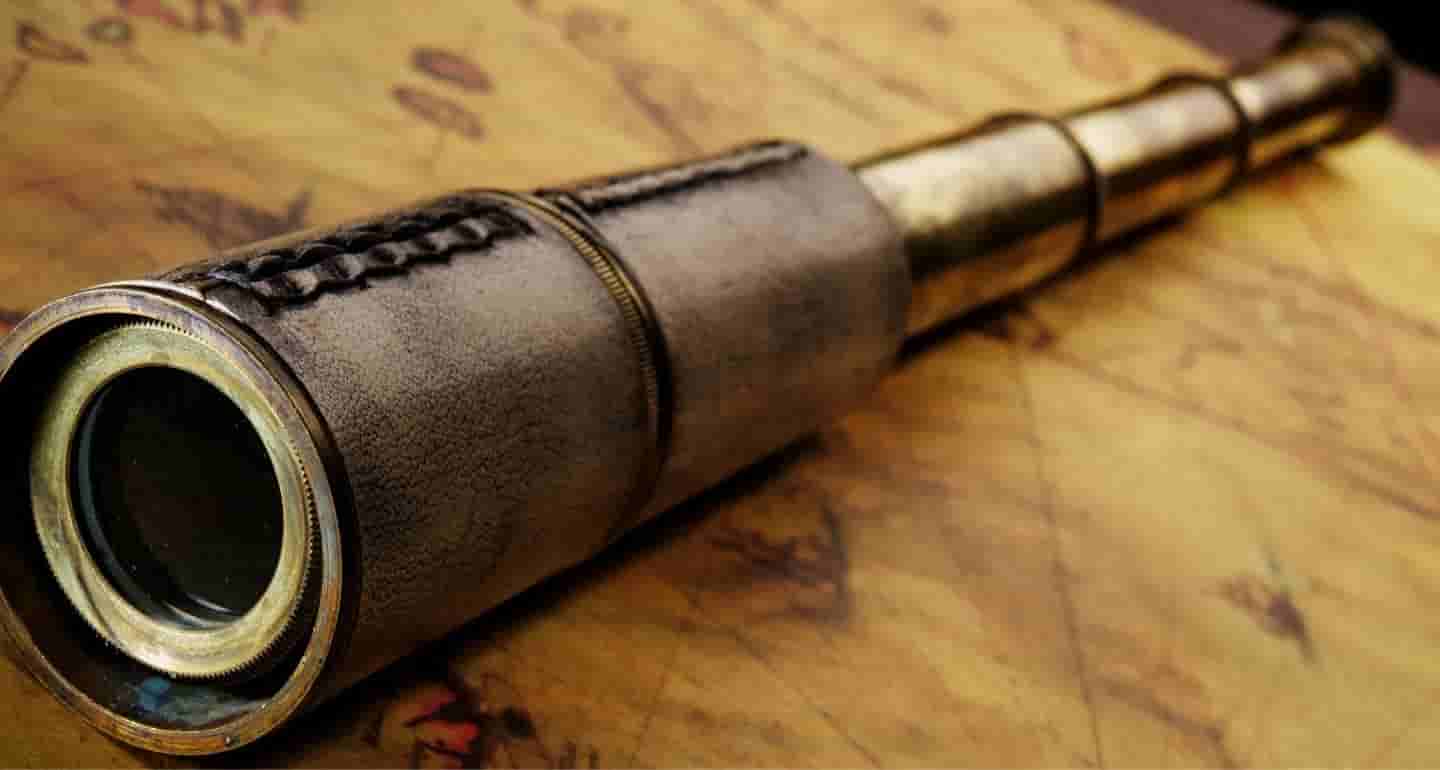
Lens
Lens is different from mirrors in a way that they are Refracting rather than Reflecting. Lens is made of optical material that is transparent meaning, when it allows the light to pass through it, the light bends because of a change in the density of the medium it is passing through.
Both surfaces are curved so that they can be either convex or concave. Lens is usually used for making spectacles. In the case of a concave lens, the surfaces are curved or bulged inside so that the light rays get diverged after passing through it.
In a convex lens, the surfaces are bulged outside so that the light rays get converged. After this, the amount of light taken by the telescopes depends on the size or diameter of the mirror or lens. The larger the diameter, the more amount of light it can collect.
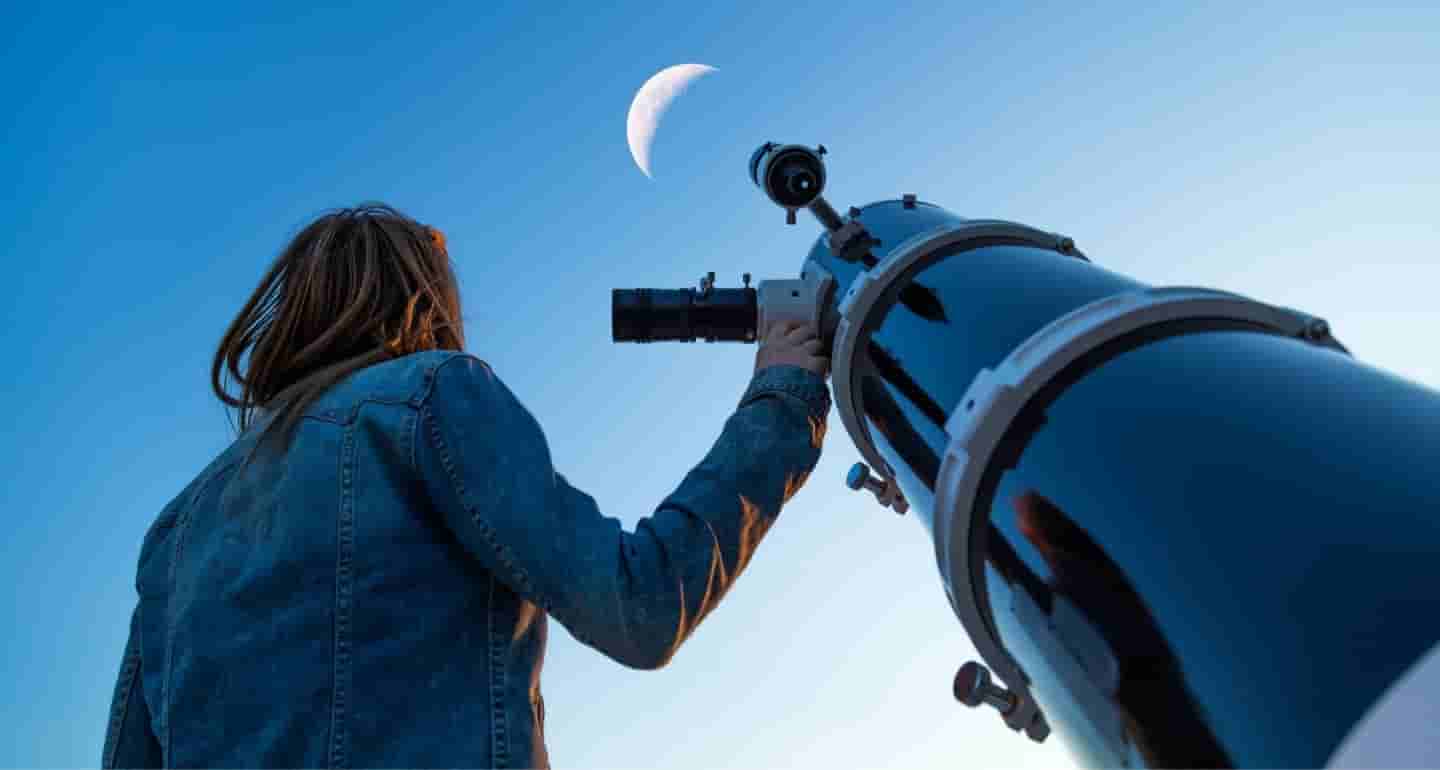
2. Telescopic Mounts
A telescopic mount or a tripod stand also plays a major role in viewing the celestial objects. This is necessary for keeping the telescope stable while it is in use. Also, it should facilitate the movement of the telescope for easy observation.
Watching stars, their movements are always fascinating and it is not just limited to people having knowledge and experience in the same. Everyone and anyone who has enough interest in star gazing.
There are lot many good telescopes for amateur observers but buying a telescope requires a lot of research. Few of the things that you should be clear with before making a purchase are as follows:
- Whether, you want to have a stationary telescope so that it can be placed on your terrace or portable one to carry.
- Whether, you just want to observe the celestial bodies or take photographs too.
- Which type of celestial bodies you want to observe: stars, comets, planets etc.

Telescopes are made using mirrors as well as lens. The ones that use mirrors are Reflecting Telescopes and the ones that use lens are Refracting Telescopes. Usually, a convex lens is used for astronomical observation.
Refracting Telescopes
In these, 2 types of lenses are used- Objective lens and Eyepiece. The eyepiece is placed at the observer’s end and the objective lens is placed at the end opposite to the former.
The light rays pass through the lens, converge at a focal point (image is formed), and pass through the eyepiece letting the observer see the formed image.
Disadvantages with Refracting Telescope
- Since the light should pass through the lens, it must be shaped precisely to get a good image.
- Also, the lens should be supported by its edge because of the same reason above. So bigger the lens, the higher will be its weight which may lead to their sagging leading to distortion of the image.
- There should not be any impurities in the lens glass or bubbles as they may lead to Chromatic Aberration.

Reflecting Telescopes
This uses a mirror as an objective for collecting the light and formation of the image. The mirror used is curved on the reflecting side (concave) and the other side is plane as well as coated. The mirror reflects the incident light rays to a focal point where an image is formed.
There are telescopes that use only one curved mirror, some use a curved mirror for image formation and plane mirror provided with the eyepiece for looking at the image.
Advantages with Reflecting Telescope:
- Only the curved surface of the mirror needs to be polished.
- Bigger mirrors can be used.
- No issue with chromatic aberration.
So, here comes the question. How can one get a bigger and brighter image? This depends on the aperture size or diameter of the objective.
If the diameter is more, then more light can be collected by the objective. That means more light from the object can be focussed which leads to the formation of a bigger, brighter, and sharper image.
The image will not be blurred if the diameter is more. In technical terms, high magnification with a sharp image. Of course, magnification can be changed by changing the eyepiece size without lowering the image quality.

Factors to consider while buying the Best Telescope in India
1. Field of View of Telescope
Field of View is the amount of sky that you can see or observe or the area of the sky that can be covered with the telescope. Focal Length – It is the distance travelled by light from the objective lens/aperture to the focal point or focus where the image is formed. It is usually measured in millimetres.
It tells how well the optical system converges (positive value) or diverges the light (negative value) . It tells you how much area can be covered or seen using the telescope.
If the focal length is more, the area that the telescope covers will be small. In other words, the Field of view will be narrow, and higher will be the magnification.
For smaller focal lengths, the field of view will be wide, and lower will be the magnification. It usually comes along with the telescope. It is NOT the length of the telescope barrel or tube. It is used to determine the Focal Ratio and Magnification in a quantitative way.

2. Focal Ratio
It is the ratio of Focal Length (in mm.) to the aperture (in mm.). It tells you how bright and sharp your image is. It is mentioned as f-stops. If the ratio is smaller, it means, the aperture is big.
So, more light can be collected and the image will be brighter and magnification will be less. If the ratio is high, the aperture is small but magnification will be high.
3. Magnification
The magnification is the ratio of the focal length of the objective lens to that of the Eyepiece. The smaller the eyepiece, the higher will be the magnification. Different types of eyepieces are used to get images of different magnifications.
So, this aperture value lets you know until what magnification power you can use the telescope for. Consider using one 100 mm aperture telescope and another with a 200 mm aperture for observing Saturn rings.
The former one will not let you distinguish between the planet and the rings as compared to the latter one. The latter one, due to its large size, takes more light and gives a sharp image.
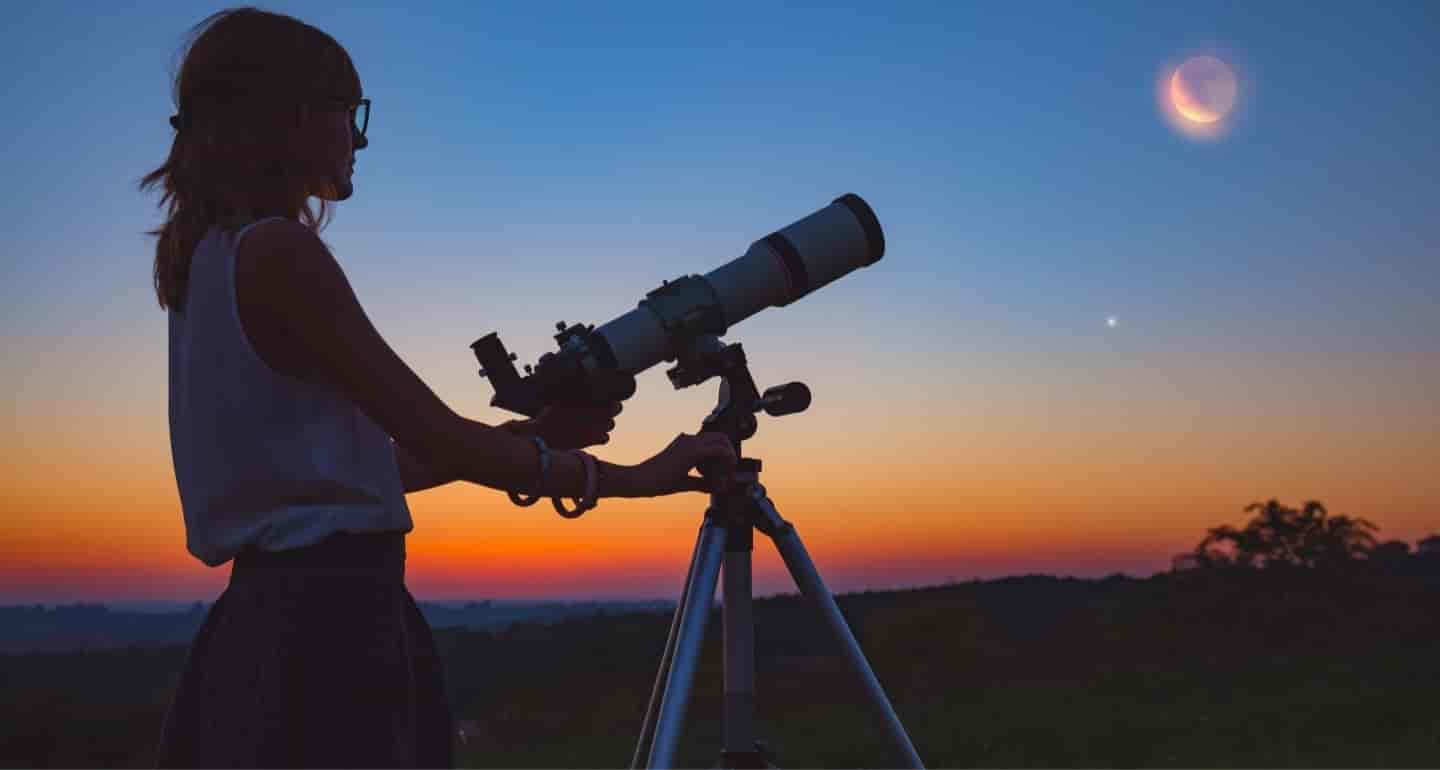
4. Barlow Lens
Barlow lens is a device that multiplies the magnification by 2 times, 3 times, or 5 times. It is a diverging lens. It is usually placed in the focuser and then the eyepiece is fixed into it.
When it is placed, the distance between the objective lens and focal point increases, i.e, the focal point moves away from the former. Hence, the focal length increases leading to increase in magnification. It also gives you eye relief.
5. Finder-scope
Finder-scope is an additional and small telescope that is mounted on the main telescope and is used to aim at a particular point you want to look in the field of view of the telescope.
The magnification of this is usually low. It has a red dot or cross-hair to pin-point the object you want to aim at. It is placed on the main telescope and aligned. It is usually of 2 types- Optical and Red dot.
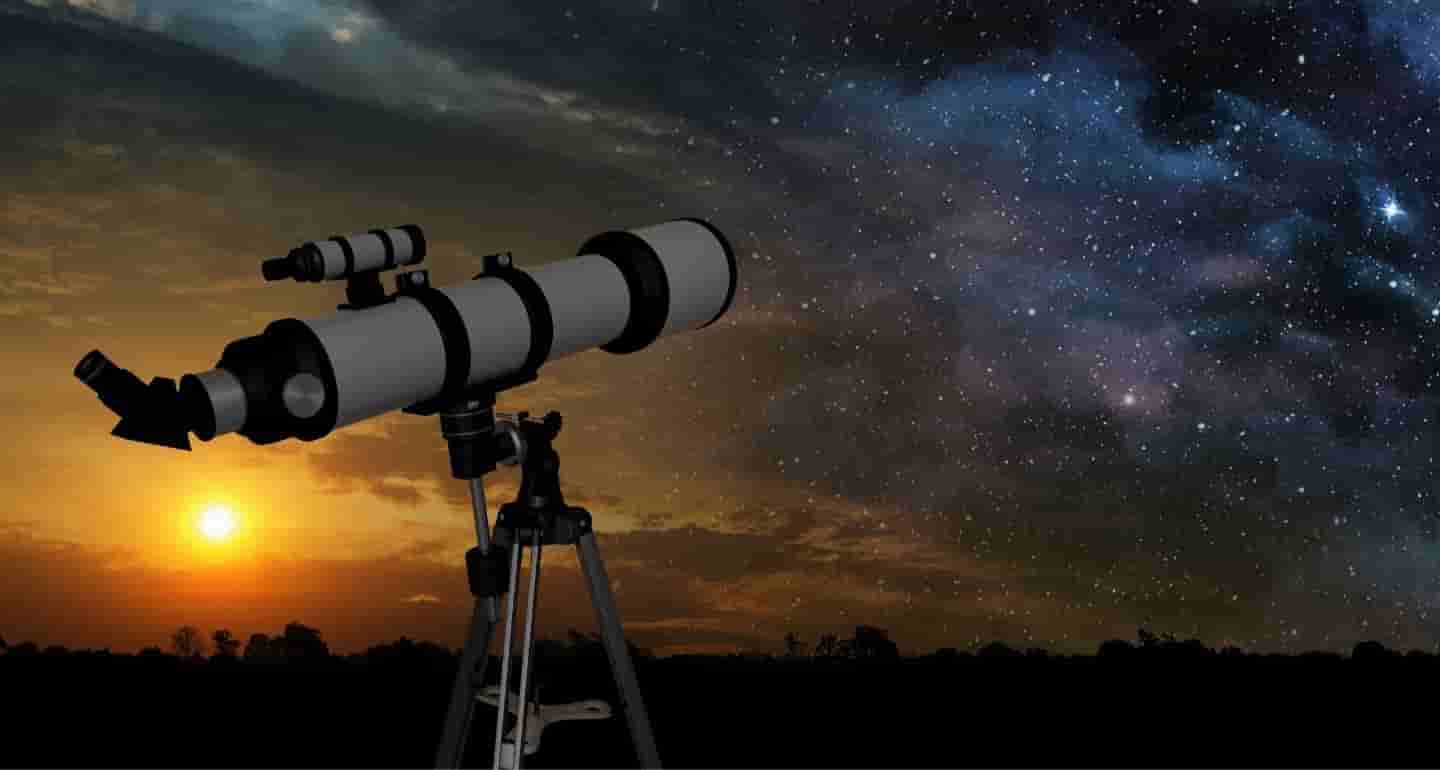
Frequently Asked Questions (FAQ’s) – Best Telescopes in India
Ans. There are 2 types: Reflector and Refractor. Though both are useful in basic as well as advanced space observation, the first one is cheaper in consideration to the latter, one needs a lens that needs to be cut and shaped precisely for accurate observation.
In a reflector telescope, a bigger aperture can be used as it uses a mirror. In the case of refractor, a bigger lens leads to their sagging, and hence distortion of the image formed.
Ans. Aperture Size
The main factor is the aperture size. If it is big, more light can be gathered and brighter, sharper and clear image can be obtained. 60mm. Aperture is very good for beginners and who want to observe fainter objects too. Magnification is not that important as it can be changed with eyepiece focal length.
Portable Or Heavy
If you want to carry it to another place, then light-weighted ones will be better. Even if you want to set a telescope at home, light-weight ones are good. So, these are key factors that you need to look into while buying a telescope as other requirements depend on these.
Conclusion – Best Telescopes in India
Based on the deep analysis & research, we would like to suggest you to go with Celestron AstroMaster 114 EQ Telescope as it satisfies all the factors mentioned above and is also affordable.

It has a good aperture, focal length, accessories for better magnification, portable, easy to carry, instruction manual. With such crisp image formation, you would fall in love to explore more and more of the vast space. To know more about this telescope, click here.
In case, you face any issue in making the right selection, let us know in the comments below!
Also Read:


